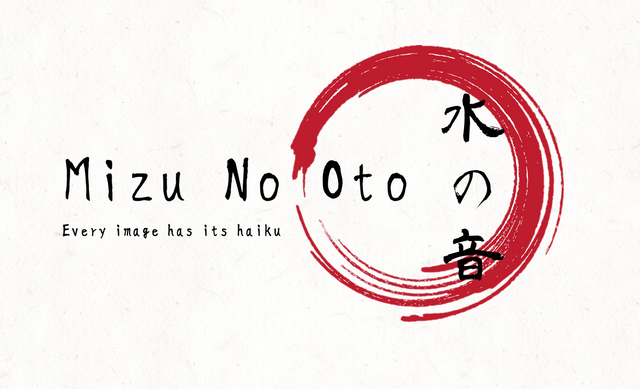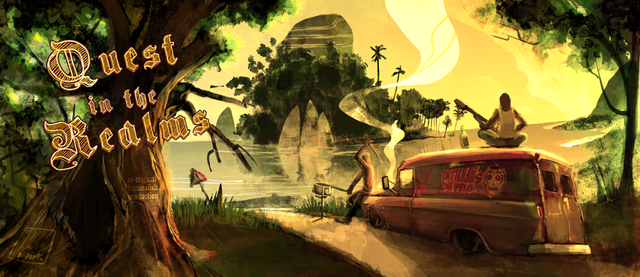Mizu No Oto - Every Image Has Its Haiku - Edition #27 (English)

haiku by Suzuki Masajo (1906-2003)
Welcome to the 27th edition of the Mizu No Oto contest, haiku friends!
Once again, we gather here on the marine fruit growing Bananafish fields, following the call of good poetry and conviviality, to revive our spirit with many small creative works.
This edition of the contest is dedicated to English haiku.
Let’s the contest begin!
[Traducción Española]
¡Bienvenidos a la 27ª edición del concurso Mizu No Oto, amigos del haiku!
Una vez más, nos reunimos aquí en los campos de Bananafish que crecen frutos marinos, siguiendo el llamado de la buena poesía y la convivencia, para revivir nuestro espíritu con muchas, pequeñas, obras creativas.
Esta edición del concurso está dedicada al haiku inglés.
¡Que comience el concurso!


For those that want to unleash their poetic potential, here is how this contest works:
• Look at the prompt image and let yourself be inspired by it.
• Write a haiku related to the prompt image. The haiku should be composed by 1-3 short verses with no title. The classical haiku form is 3 verses of 5/7/5 syllables, but other forms are allowed, as long as they remain in absolute brevity.
• The haiku should be in English or include an English translation.
• Post the haiku on your blog or in the comment section below this post. If you make your own post, don’t forget to put the link to it in the comment section below!
Don't forget to use the tag:
#haikucontest
Watch out for the @bananafish comment to this post, under which you can cast your vote (and try to win the Best Comment award)
Join the Bananafish Realms on Discord and chat with us: https://discord.gg/ZWmEUWT

Prompt Image:
.jpg)
[photo by @marcoriccardi]

• Kireji (切れ字), a cut between the 1st and the 2nd verses, or between the 2nd and the 3rd; the cut can be grammatical, as a sign of punctuation, or it can be a cut in the meaning, like two different images.
• Kigo (季語), an explicit or implicit reference to a season, that defines the time of the year in which the haiku is composed or referred to.
• Sabi (寂), the sense of the inexorable passage of time, the beauty or serenity that accompanies the advance of age, when the life of the objects and its impermanence are highlighted by patina and wear or by any visible repairs.
• Wabi (侘寂), the taste for frugal and natural things, rustic simplicity, freshness or silence; it can be applied to both natural and artificial objects, or even non-ostentatious elegance.
• Mono no aware (物の哀れ), empathy with nature and human life; the "feeling of things", nostalgia, regret for the passing of time, understanding of the changeability and of the transience without suffering.
• Yūgen (幽玄), sense of wonder and mystery; it represents the state of mind produced by the inexplicable fascination of things, the feeling of an 'other' universe, full of mysterious unity.
• Karumi (軽み), beauty in simplicity; poetic beauty reflected in its simplicity, free from preconceptions and moral judgment.
• Shiori (しおり), gentleness; the levity and the delicate charm that radiates from the verses, where things are evoked in the reader without aggressiveness or excessive explicitness.

Submission deadline: Wednesday 10th April, 10:00 PM, GMT +1 (Rome Time).
The results will be out on Thursday 11th April, 10:00 PM, GMT +1 (Rome Time).

The kigo and the hon’i
In today's theoretical article, after having finished talking about the formal aspects of haiku, we begin to explore the content aspects.
As always, these reflections come from reading the essay by Luca Cenisi “La Luna e il Cancello” (The Moon and the Gate).
The first element of content, perhaps the most important for traditional haiku, is the kigo (季 語, season word).
It is a reference to one of the natural seasons that originates from the first stanza of the renga.
Its importance is very great, because in Japanese poetry, man is not an isolated individual, but part of nature. The link between man and nature brings a feeling of enlightenment similar to Nirvana.
Composing a haiku is, to a large extent, making explicit this feeling, that comes from the direct observation of a natural phenomenon (large or small, often tiny). The poet tries to look at the object from within. Knowing the flower is like becoming a flower.
Japan, a land of very intense and colorful seasons, with its very green springs and snow-white winters, has produced a culture in which the seasons have great spiritual significance.
To express a kigo it is not necessary to be explicit in naming the season. Very often, it is sufficient to evoke an image that allows the reader to identify the time of the year to which the haiku refers.
To help poets and readers, there are large catalogs called saijiki (almanac of annual events), which collect thousands of kigo (the largest has about 25,000) from which to take inspiration. The saijiki are divided by season and on the basis of seven categories: climate, celestial phenomena, terrestrial phenomena, daily life, holidays, animals and plants.
The animals include only the wild species, with the exception of neko no koi (cats love), a spring kigo.
Attempts have been made to create saijiki even in other languages, but the opinion of modern haiku masters, both Japanese and foreign, is that one should not rely solely on these catalogs mechanically, but take them only as one cue to process and keep alive.
Seasonal expressions do not only frame a period of the year, but also refer to a deeper shared socio-cultural meaning, called hon'i (本意, original meaning).
Some expressions have a very strong value, to the point that both the poet who uses them and the readers immediately refer them to a context that has precise connotations in the history and culture of the country.
For example, the expression chiru sakura (fall of cherry blossoms) is a spring kigo, but its hon'i is inextricably linked to the memory of the kamikaze pilots of World War II, which the war propaganda compared to cherry blossoms falling into the sea.
Therefore, a poet who wants to use this expression must take into account the painful meaning that it brings, and that will give a very precise meaning to the haiku: regret, pain, the remembrance of a generation sacrificed in the prime of life to the patriotic ideal.
I conclude with this, and leave you to compose magnificent haikus, hoping that the photo will be a harbinger of inspiration.
[Traducción española]
El kigo y el hon’i
En el artículo teórico de hoy, después de haber terminado de hablar sobre los aspectos formales del haiku, comenzamos a explorar los aspectos del contenido.
Como siempre, estas reflexiones provienen de la lectura del ensayo de Luca Cenisi "La Luna e il Cancello" (La Luna y la Puerta).
El primer elemento del contenido, quizás el más importante para el haiku tradicional, es el kigo (季 語, palabra de temporada).
Es una referencia a una de las estaciones naturales que se origina en la primera estrofa de la renga.
Su importancia es muy grande, porque en la poesía japonesa, el hombre no es un individuo aislado, sino parte de la naturaleza. El vínculo entre el hombre y la naturaleza trae un sentimiento de iluminación similar al Nirvana.
Componer un haiku es, en gran medida, hacer explícito este sentimiento, que proviene de la observación directa de un fenómeno natural (grande o pequeño, a menudo muy pequeño). El poeta trata de mirar el objeto desde dentro. Conocer la flor es como volverse una flor.
Japón, una tierra de estaciones muy intensas y coloridas, con sus manantiales muy verdes e inviernos blancos como la nieve, ha producido una cultura en la que las estaciones tienen una gran importancia espiritual.
Para expresar un kigo no es necesario ser explícito al nombrar la temporada. Muy a menudo, es suficiente evocar una imagen que permite al lector identificar la época del año a la que se refiere el haiku.
Para ayudar a los poetas y lectores, hay grandes catálogos llamados saijiki (almanaque de eventos anuales), que recopilan miles de kigo (el más grande tiene alrededor de 25,000) de los cuales puede inspirarse. Los saijiki se dividen por temporada y en base a siete categorías: clima, fenómenos celestes, fenómenos terrestres, vida cotidiana, vacaciones, animales y plantas.
Los animales incluyen solo las especies silvestres, con la excepción de neko no koi (amor de los gatos), un kigo primaveral.
Se han hecho intentos para crear saijiki incluso en otros idiomas, pero la opinión de los maestros modernos del haiku, tanto japoneses como extranjeros, es que no se debe confiar mecánicamente solo en estos catálogos, sino que hay que tomarlos solo como un indicio para procesar y mantener vivos.
Las expresiones estacionales no solo enmarcan un período del año, sino que también se refieren a un significado sociocultural compartido más profundo, llamado hon'i (本意, significado original).
Algunas expresiones tienen un valor muy fuerte, hasta el punto de que tanto el poeta que las usa como los lectores se refieren de inmediato a un contexto que tiene connotaciones precisas en la historia y la cultura del país.
Por ejemplo, la expresión chiru sakura (caída de las flores de cerezos) es un kigo primaveral, pero su hon'i está indisolublemente ligado a la memoria de los pilotos kamikaze de la Segunda Guerra Mundial, que la propaganda de la guerra comparó con flores de cerezo cayendo al mar.
Por lo tanto, un poeta que quiera usar esta expresión debe tener en cuenta el significado doloroso que conlleva, y eso le dará un significado muy preciso al haiku: arrepentimiento, dolor, el recuerdo de una generación sacrificada en el apogeo de la vida al ideal patriotico.
Concluyo con esto, y os dejo para componer magníficos haikus, esperando que la foto sea un presagio de inspiración.

Good haku to everybody!
Your bananafish haiku fan #1


Let’s the Bananafish Tribe grow together!

With delegations, Bananafish VP will grow and consequently the upvotes given to every contest entry will be higher.
Following the voting trail is a way to make sure you always support the other participants to the Bananafish contests, automatically upvoting the posts (but not the comments) Bananafish upvotes.
Join the Bananafish Realms on Discord and chat with us: https://discord.gg/ZWmEUWT
If you’re interested, here you can find all the information needed.

[banner credit: @f3nix]
Other Bananafish awesome activities:
Bananafish Knights interesting creative works:
@cyemela:
Red Roses, an interesting audiobook which he describes as a “Shakespeare meets Voltaire retelling of Richard III [that] helps to change the perception of this former English King”.
You can find it here: https://www.downpour.com/red-roses?sp=274337
Steemit Blog: Contests, on Kindle or parperback, that “offers 180 pages of high octane performance driven Steemit blog contest entries from the author while giving you the contacts you’ll want to know in order to begin your contest career on the Steemit blockchain.”
https://www.amazon.com/gp/product/B07MVPT72Q?pf_rd_p=c2945051-950f-485c-b4df-15aac5223b10&pf_rd_r=JJKTKWBJWMDK97NQAVRR@dirge:
Reports on Trepidation, on Kindle, is a collection of short stories; “written with a preference for realism, these stories offer plausible scenarios of the grotesque, pessimistic or supernatural.”
https://www.amazon.com/dp/B07375V8PV



Alone on the shore
Watching the waves pass on by
Contemplating life
Posted using Partiko Android
Welcome to Mizu No Oto! Nice debut!
My boat is always half full
Happy summer mind
I like the subtle humor. You were also one of the few who recognized a lake (many wrote the sea)
I'm glad you liked it :) It's definitely not Jim Beam ;)
Haiku lovers, with my love I also leave my entrance to the contest:
Also a boat gets old
and falls, sinking.
After my publication I keep thinking about the idea of the boat as the cradle of mermaids.
I'm going to share them
sinks with grace,
cradle of sirens.
I love your second haiku! Rethinking about it has been a good choice.
An old ship, lonely.
Will the fish live in it? now.
Speaks! Tell me! Please.
It looks like a haiku?
Thank you
Sort of haiku...yes! But I'm sorry, it came too late, submission time has expired
Dear @bananafish,.
Thank you for your kind response.
I am happy to have been able to achieve a Haiku.
It is never late when, happiness is good.
Happy life.
Sinking beneath
A single chain holds on -
Winter lets go
All the three haiku are beautiful, but after a lot of thinking, I want to consider this first one for the contest. Beyond the deeper meaning of the third, this one sounds better to me.
I wasn't going to enter again and who knows if I made the deadline, and I know only one entry will count but I am just doing my evening class and this came to me and so seizing the moment and sharing ❤️
Sunlight on water
The roots of reeds sink deep
Tranquil comes the flood
My entry:
Thawing river flows
revealing what was hidden;
faded memories
By: @Wolffeys
https://steemit.com/haikucontest/@wolffeys/my-entry-mizu-no-oto-every-image-has-its-haiku-edition-27
Love these #contests! Thanks, @bananafish!!!
Here's my turnout for this week. Blessings to everyone.
Vote your favorite haiku down here
My upvote is for @josegilberto, because of his haiku structure, 5-7-5, in both, English and Spanish
I enjoyed this 5-7-5 haiku at the end of @cyemela haibun (which I have to admit I do not know what that is). The story and the haiku along with the photo prompt amused me. It has many of the characteristics of a wondrous haiku (kigo, sabi, and mono no aware among them), but shiori is the predominant characteristic for me - I laughed out loud when I read it and envisioned the characters trying to stage a futile little party in that boat. Summer!
Summer hope, water -
The tea trip must be postponed,
not a party boat.
Here is a link to his post:
https://steempeak.com/haikucontest/@cyemela/mizu-no-oto-haiku-contest-week-27-bananafish
Thanks. A haibun is another ancient form of Japanese writing that combines prose with haiku.
Thank you and well done then! I got a much clearer picture from the Haiku having read the prose.
Thanks, every week we improved the knowledge about the japanesse literature.
My vote in a nutshell is for @josegilberto...
gracielaacevedo's entry: The disused boat..
My vote this week for the 27th edition of haiku in English is for @josegilberto
Hi friends! I´m here again with a poem:
https://steemit.com/spanish/@salvao/mypoemformizunooto-edition27espeng-v9g2b9ajwm
Pequeña barca
sumergida al olvido.
Rumor de peces.
(An English translation)
Small boat
submerged into oblivion.
Fishes rumour.
Buen contraste, olvido, quietud, inmersión por un lado y por el otro el bullicio de la vida,
el rumor de peces @salvao.